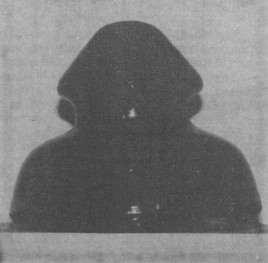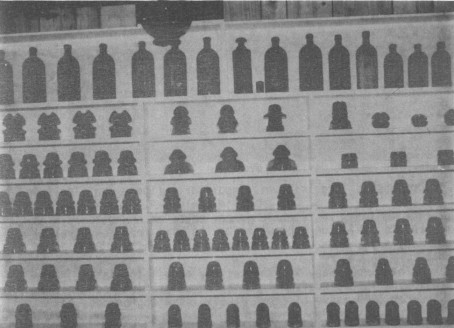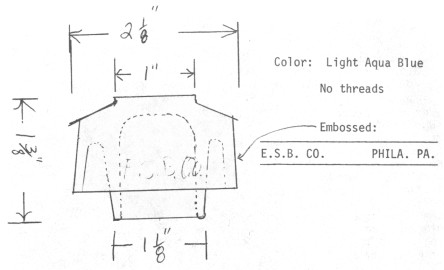Research Division
Reprinted from "INSULATORS - Crown Jewels of the Wire", July 1981, page 27
Dear Dora,
I'm enclosing a photo of a Calif. CD 178 in Royal Purple in hopes you or
any of your readers can shed some light on it. I traded another insulator for it
about a month ago. Since then I've asked other collectors their opinion on it
and would welcome responses from other collectors in regards to this piece or
other styles of Calif. in Royal Purple. Any help you or your readers could offer
would be appreciated.


Am also enclosing a photo of my Calif. collection. If you
can use either or both of the photos and letter in Crown Jewels, please feel
free to do so.
Thank You
Ted Griffin
305 E. Clark Rd.
Ypsilanti, Mich. 48197

Could anyone please send me some information and value about this piece
of glass (possible insulator, cap, etc.?).
Gordon F. Bouza
4433 Castlebar
Boise,
Idaho 83703
- - - - - - - - -
The following information (from pages 17 and 18 of the July 1975
Crown Jewels) should be of interest to you and perhaps others.

- Unembossed
large size oil insulator. (These are also found embossed "The E.S.B. Co.-
Made in the U.S.A." Aqua.
- The medium size, emerald green, embossed on
bottom: "The E.S.B. Co. Chloride Accumulator". (A gift from Ken Eisele.)
- Mini size, aqua, embossed "E.S.B. Co., Phila., Pa."
Thank you, Ken,
for the battery or oil insulator. The following is copied from information we
printed back in the December 1969 issue of Crown Jewels, starting on page ten,
sent in to us by Don Shinner:
"This is an oil insulator, manufactured by
Electric Storage Battery Co., Rising Sun & Adams Av., Philadelphia 20, Pa.
This insulator has not been manufactured since 1918, and I am not sure at what
date they quit producing these. A better means of production did away with
these. These insulators were used on storage batteries.
"We have a
'mini' insulator of this type. It is embossed 'E.S.B. Co./PHILA. PA.' It is
green in color and 2-1/8 inches diameter, inside hole 7/8 inch across, 3/4 inch
deep, middle stem is 1-1/8 inch across, 5/8 inch long. Overall bottom diameter
is 2 inches.
"I have the following information on these insulators.
'Whenever a number of open cells are in use, unless precautions be taken,
electrical leakage between the cells invariably occurs. This leakage is due
chiefly to the semi- conducting nature of the thin layer of moisture which
frequently covers not only the glass containing the cells, but the unimmersed
parts of the elements, and over the shelves on which the cells rest. To prevent
this waste of energy, the outside of the cells should occasionally be well
cleaned and thoroughly dried. Electrical leakage is greatly reduced if each cell
be mounted on a glass earthen-ware insulator, as shown in the illustration. The
insulator here shown is in two parts and of a mushroom shape. The lower cup
contains a small quantity of some non-evaporating oil, and as the conducted
moisture cannot bridge across this, a nearly perfect insulating medium is
obtained. These insulators are made in various sizes and may be obtained in
earthen-ware or glass. Those made of glass are found to give the best
results.'"

Dear Mrs. Harned,
Regarding the letter to Jack Tod and the
drawing on page 23 of the April 1981 issue of C.J. -- I have a Jeffrey-Dewitt
insulator in the exact measurements as given in the drawing with the J.D.
monogram and ink stamped Mfg. Dec. 1933. It has a top-firing surface and a metal
threads thimble -- but it has a brown glaze.
Also is there any place where I can
get an insulator color chart?
Thanks for a great magazine.
Leslie J. Tyler
R.D.
#2 Box 415
Narrowsburg, NY 12764
A question in regards to C.D. 169 made by both
Hemingray and Whitall Tatum Cos. Was this design made specifically for
transposition use? Referring to page 28 of J. C. Tibbits, volume 2, it appears
to be possibly so.
In this same volume 2 on page 30 is a bit of information I
have never seen mentioned in C.J. The illustrated insulator is the C.D. 245. I
suspect that very few collectors know that it is an oil insulator that requires
a glass insert to be complete, as it is not mentioned in Mr. Milholland's good
book.
W. Hunter
Du Bois, Pennsylvania
| 